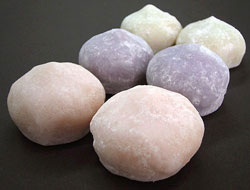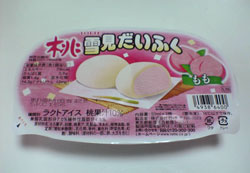
Mochi is pretty cute. Essentially, it’s white rice that’s been pounded and mushed up to make a sticky, glutenous glob of empty carbs. It can be eaten a number of ways – it’s delicious when baked for a crispy outside and with a splash of soy sauce, or it can be the “meaty” part of a sweet soup made of beans, or it can be not eaten at all, and instead used as a symbolic (and highly decorative) gift to ancestors. Japanese people make it on New Year’s, and there’s reportedly a mochi-making rabbit that lives on the moon.

The best mochi is sweetened up, flavored with green tea or sakura, and filled with sweet adzuki beans or ice cream. Some people, of course, don’t care for mochi. They often remark on how much the texture reminds them of human flesh.
The term “mochi-mochi” is a little different. It’s an onomatopoeic word that is basically the sound of something that is sticky like mochi. Here is the example sentence given by my Giongo Gitago Dictionary (translated by me):
The August air is mochi-mochi[ly] sticky.
Mochimochi Land toys aren’t intended to be sticky, but to have a somewhat chewy-seeming quality to them, I guess. I haven’t chewed any yet myself, but if I were to, I would hope that they bring to mind New Year’s traditions, the mochi-making moon rabbit, and – why not – the smooth elasticity of human flesh.
